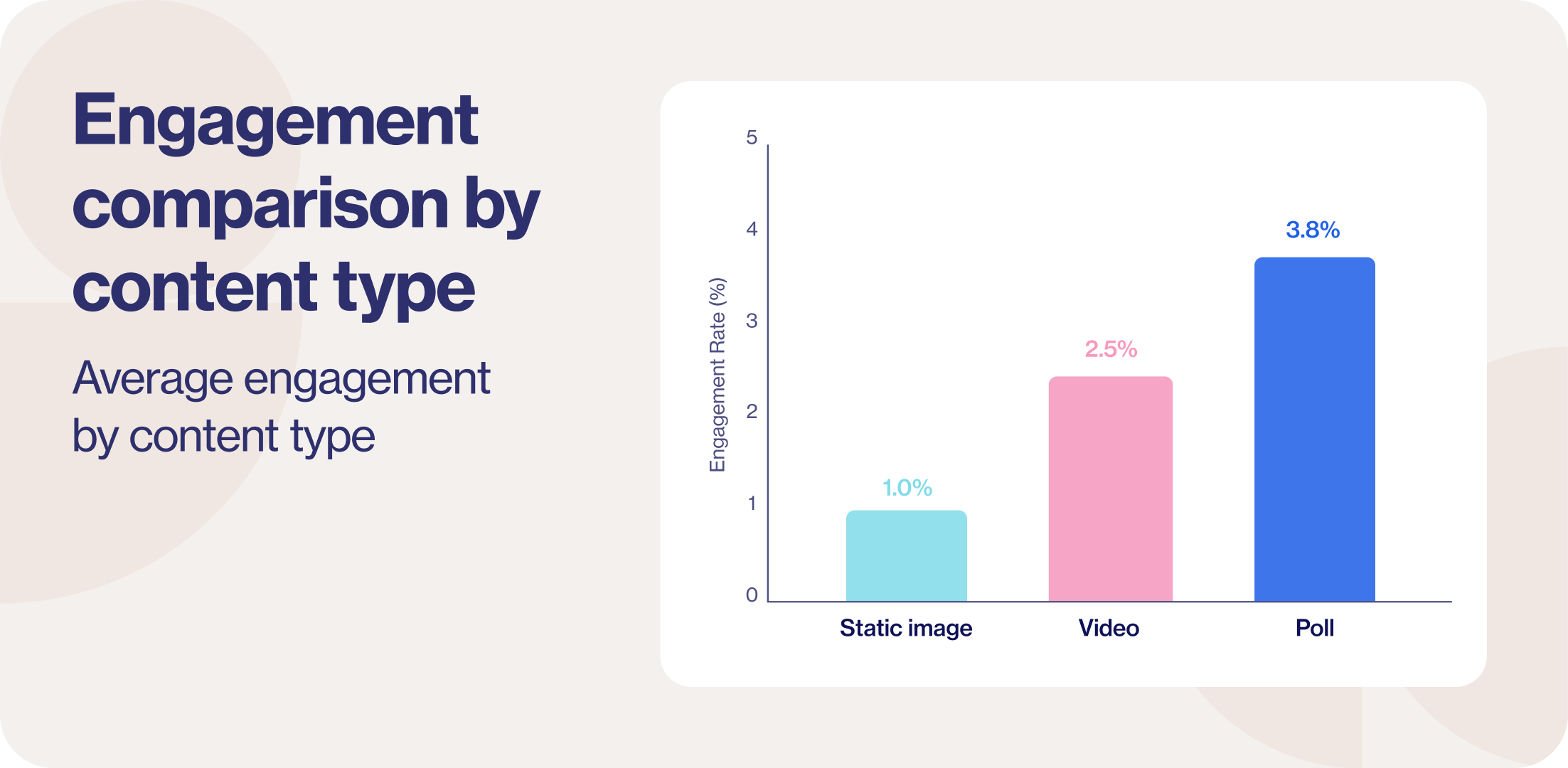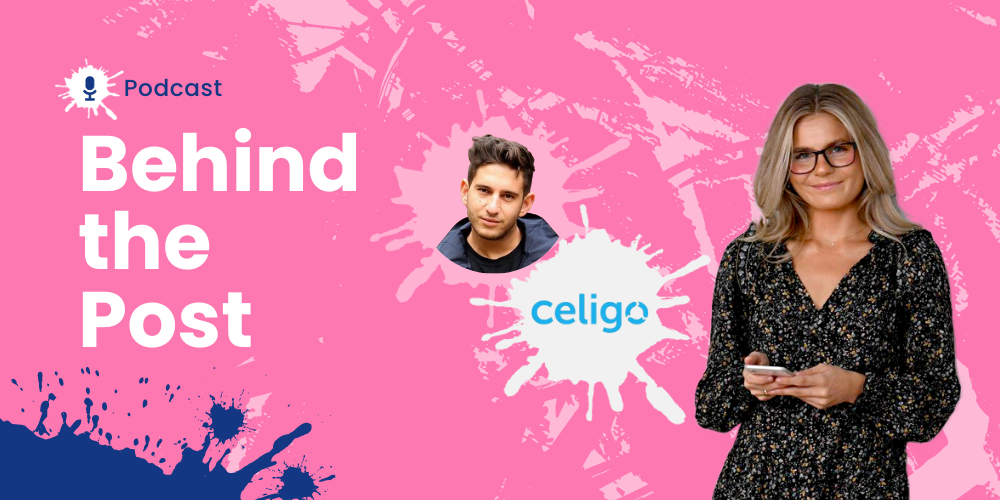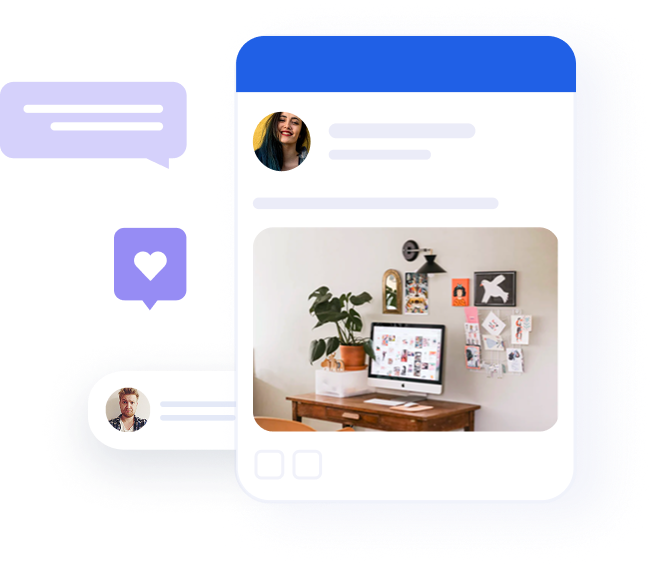How to fix Inefficient social media engagement in B2B marketing
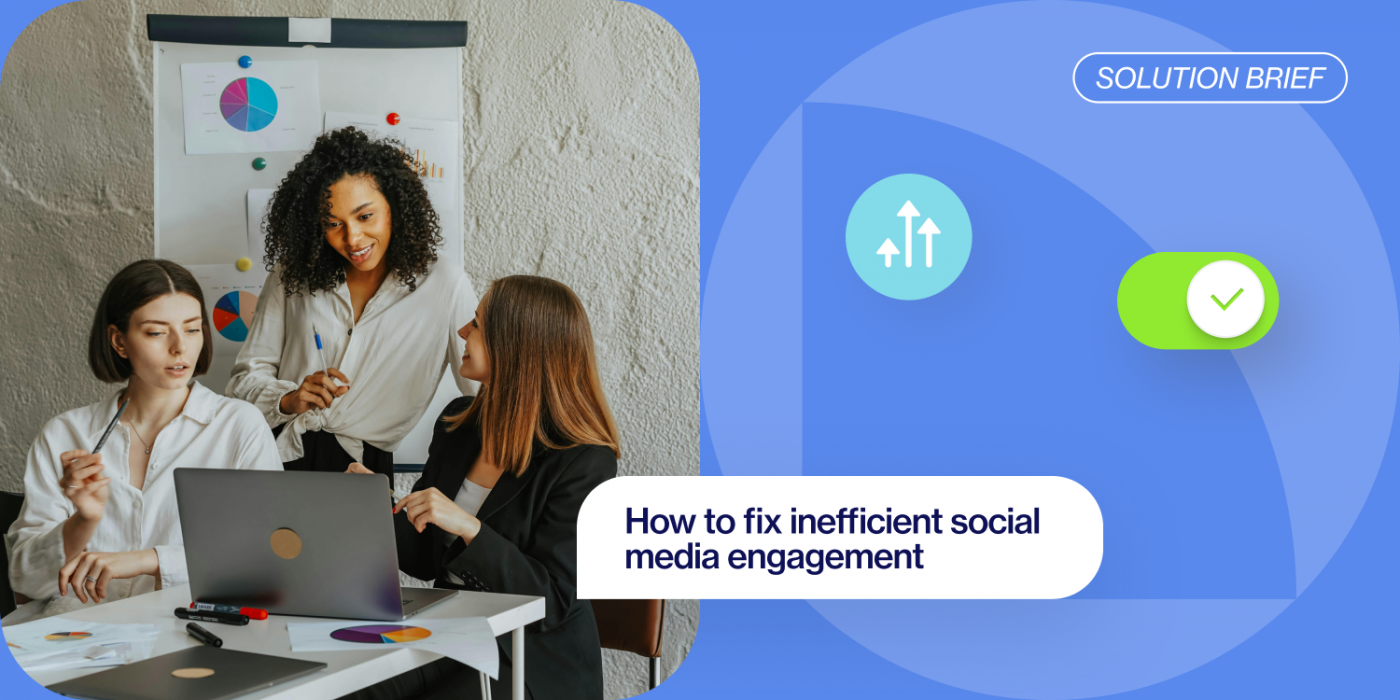
Table of contents
Introduction
In B2B Marketing, social media isn’t just a branding tool; it’s a vital engine for lead generation, thought leadership, and customer engagement. Yet many companies struggle with what we call inefficient social media engagement. Despite consistent posting and growing follower counts, engagement stays low. Also, despite the effort B2B marketers put into content calendars, visuals, and scheduling, many still see underwhelming results. Likes trickle in. Comments are sparse. Shares are rare. The result? Disappointing visibility, lack of traffic, and fewer leads than anticipated.
This guide examines the root causes of inefficient social media engagement, explains why it occurs, and provides a strategic playbook to address the issue. You’ll learn actionable insights backed by real Oktopost case studies and repeatable processes to help you regain traction and drive business impact.
Whether you’re a social media manager juggling platforms or a marketing leader looking to prove ROI, this guide will help you move from disconnected posting to meaningful engagement.
Understanding inefficient social media engagement
What does “inefficient engagement” really mean?
It’s not just about a lack of likes. Inefficient engagement refers to a mismatch between the effort invested and the outcomes achieved. You’re active on social, but you’re not seeing the results: content is being published, but interaction remains low.
It’s when the content you posted and shared consistently fails to drive interactions.
Your content fails to generate responses, such as likes, comments, shares, or clicks, despite being active and posting regularly on social media.
Why low engagement hurts B2B brands
For B2B, engagement is often the bridge between awareness and action. Without it:
- Your content reaches fewer people due to platform algorithms.
- Reach decreases organically
- Lead generation slows down.
- Your brand loses its voice in the conversation.
According to Oktopost research, B2B posts without external links generated an average of 8.89% engagement, while link-heavy posts dropped to 5.01%. That means not just what you post—but how you post—directly impacts your visibility.
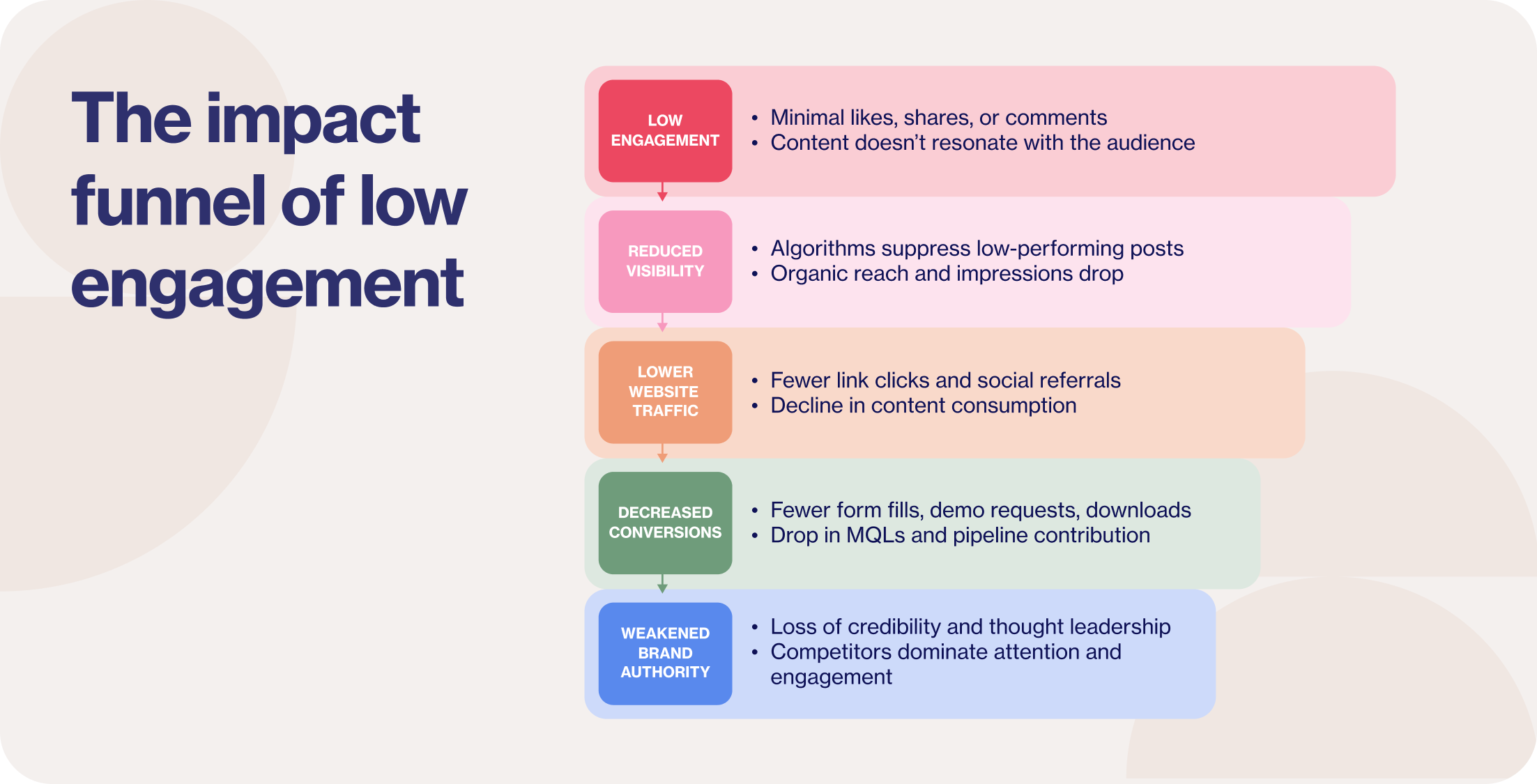
“Since becoming an Oktopost customer in 2019, IFS has published over 240K posts, generated 4.5 million engagements, amassed 547K link clicks, secured 3.12 million followers, and triggered 113K brand mentions. Additionally, there has been a 394% rise in engagement in the past two years.” — Oliver Pilgerstorfer, CMO, IFS.
Common causes of poor social performance
If social engagement is lagging, the first step is to conduct a diagnosis. Common causes include:
- Content that misses the mark
You might be posting regularly, but if the content is overly promotional, off-topic, or lacks relevance, it will fail to connect. B2B audiences crave insight and value—yet too many brands still post product features instead of customer-focused outcomes.
- Poor timing and frequency
When you post matters, inconsistent posting, missing peak hours, or flooding feeds can damage your engagement rate.
- Platform misalignment
A post that works on LinkedIn won’t necessarily succeed on X or Instagram. Each channel has unique formats, cultures, and expectations.
- Lack of employee advocacy
Your people are your most powerful amplification channel. If they aren’t engaged in sharing and supporting content, your reach remains limited.
- No strategic alignment
If there’s no documented strategy—just reactive posting—your audience will sense the disconnect. Without a clear tone, message hierarchy, or content themes, engagement tends to decline.
How to diagnose platform-specific engagement issues
A common mistake is posting content that talks at people instead of speaking to them. Many B2B companies fall into the trap of pushing products rather than solving audience problems.
Example: A software company that only posts product updates vs. one that shares customer success stories or industry tips.
Poor timing and posting cadence
Posting too infrequently leads to low visibility. Too often, posts without value can also annoy followers. Posting when your audience isn’t active makes it worse. Hubspot published timing recommendations for posting on different networks.
Platform mismatch
Each social network serves a different purpose. LinkedIn is built for professional insights, Instagram leans visual, and X rewards brevity and immediacy. Adjust your content strategy to the network you are posting on.
No real strategy
When there’s no clear voice, goal, or schedule, engagement suffers. Content becomes reactive instead of intentional.
Below is a breakdown of typical engagement issues by platform, with example metrics and associated root causes. Use this as a diagnostic tool to guide your improvement strategy.
Typical engagement issues by platform
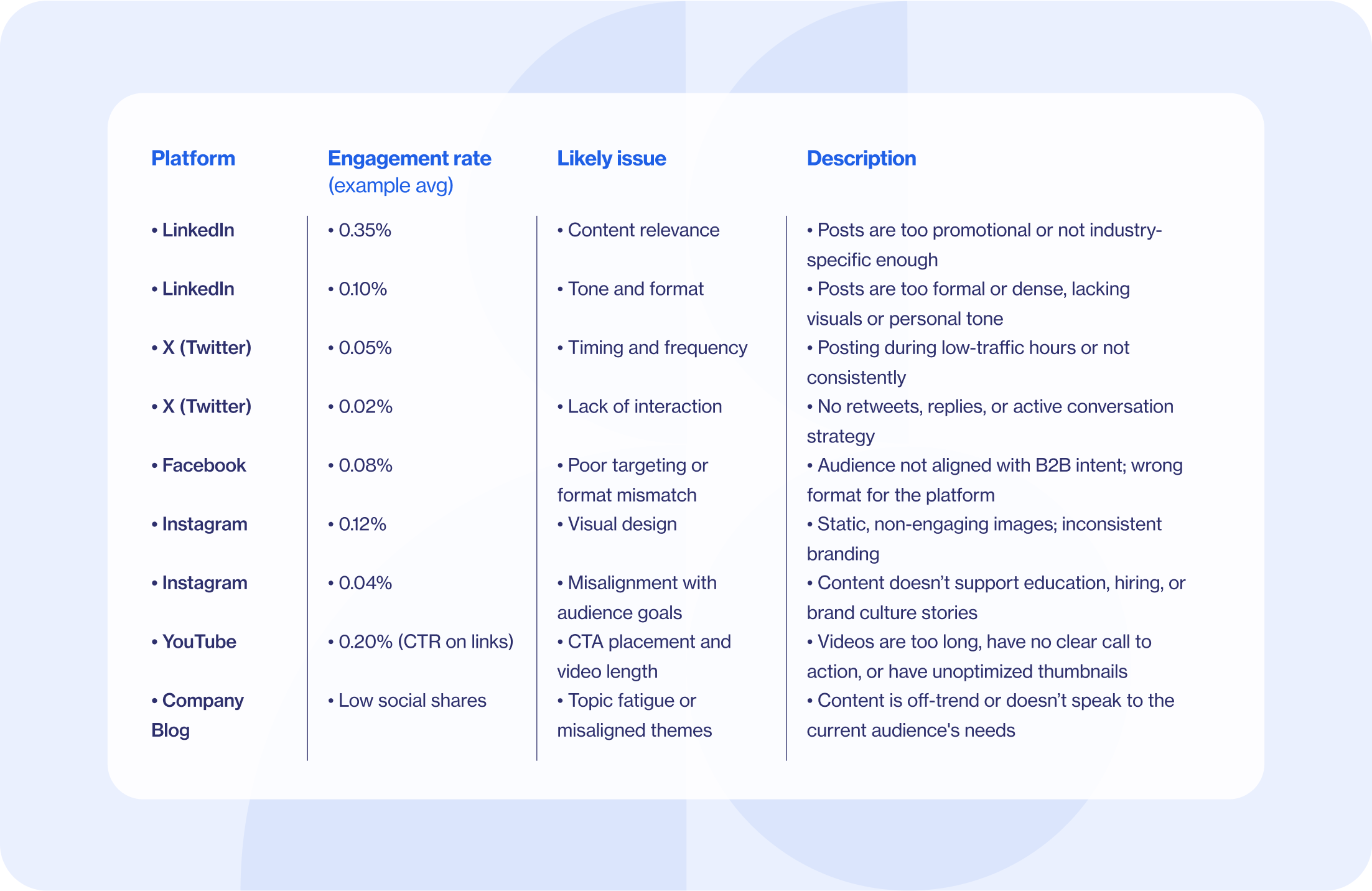
Strategies to boost B2B engagement
Create audience-first content
Consider your personas: What are their key pain points? What do they need to do their jobs better?
Actionable ideas:
- Share customer success stories
- Provide how-to tips or tool comparisons.
- Offer industry commentary or predictions.
- Use humor (tastefully) to humanize your brand.
2. Master platform-specific formats
Don’t copy and paste the same caption across platforms; tailor content to channel expectations.
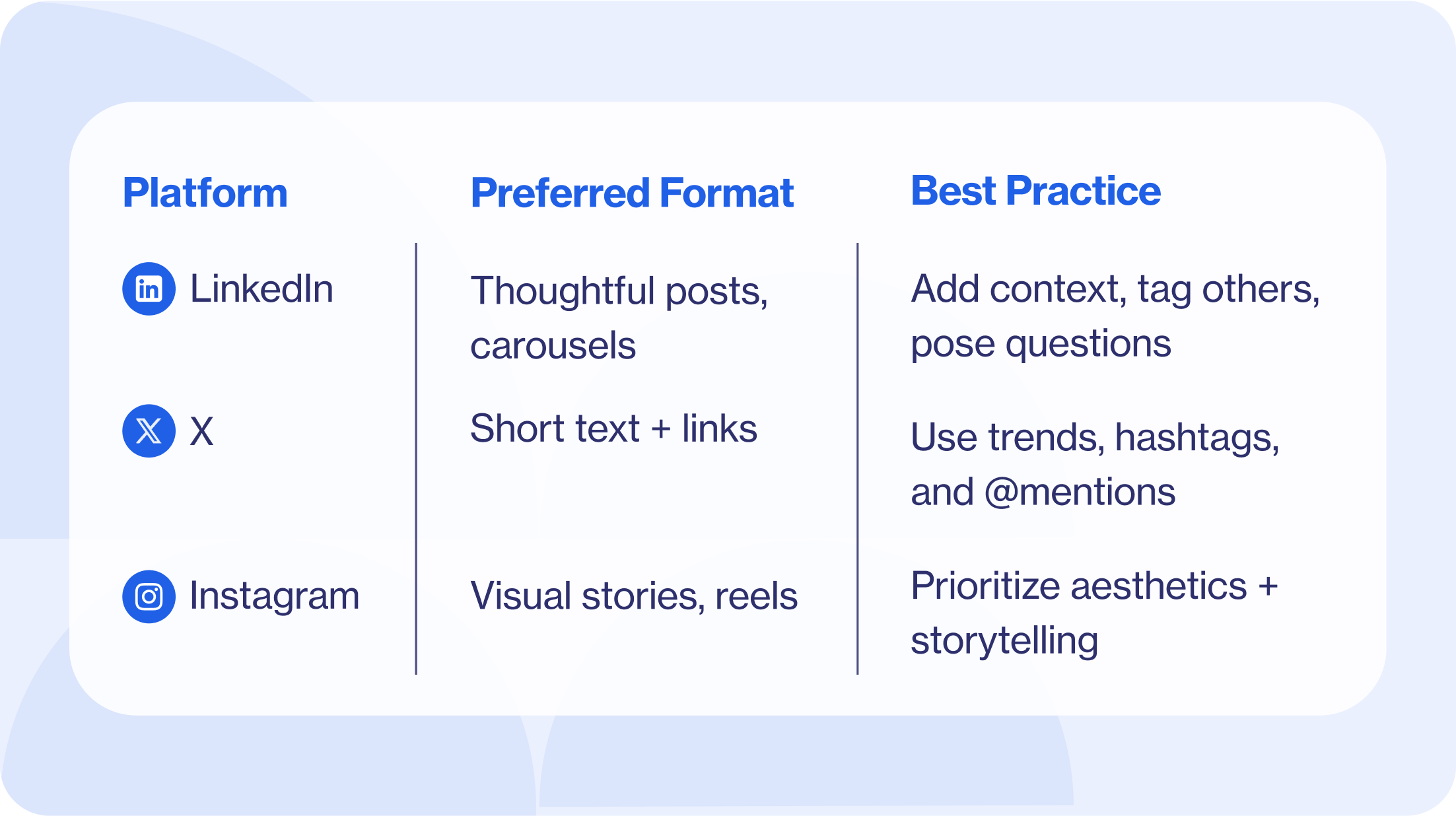
The best engagement comes from solving problems. Use industry trends, tips, user-generated content, behind-the-scenes posts, and thought leadership.
“We started with just 20 people, but in four months, we scaled to over 100 advocates, and now we’re consistently maintaining a group of 125 to 140. It’s been incredible to see how much we’ve grown and how much traffic we’re driving to the website; 14% of users now come from social.”— Nina Humphrey, Hymans Robertson
“We took a look at our growth pre- and post-advocacy, and it’s higher across pretty much all networks in the previous six months in terms of follower growth. It’s supported and accelerated the kind of explosive growth we see on LinkedIn in particular.” — Mathan Allington, Beyond Bank.
Get strategic about timing.
Utilize built-in analytics or social data to pinpoint high-engagement periods. Consider time zones, buyer personas, and work schedules to ensure a seamless experience.
Use interactive and rich media formats.
Polls, carousels, short videos, and infographics generate more engagement than static text posts.
Example: A short video summary of a whitepaper with a CTA outperforms a post linking to the whitepaper alone.
3. Make content interactive
Polls, AMAs, “comment below” posts—these invite engagement rather than broadcasting messages.
This bar chart visually represents the average engagement rates for three standard content formats: static images, videos, and polls.
Static Images (1.0%): While easy to produce, static images tend to have the lowest engagement rates due to their passive nature.
Videos (2.5%): Videos are more engaging than static images, offering dynamic content that can capture attention more effectively.
Polls (3.8%): Polls encourage direct interaction, leading to the highest engagement rates among the three formats.
4. Empower employees to advocate
Employees’ networks are trusted and relevant when they share, and engagement skyrockets.
“Within 6 months of using the Oktopost platform, employees shared 10X more posts, increasing Fujitsu’s social reach by 70%. Employee advocacy gave them 3.6 times better ROI than paid social.” — Daniel Klaus, Fujitsu
Leverage the right tools and automation.
Oktopost’s platform simplifies execution:
Centralized content scheduling
Keep all teams aligned with a single editorial calendar.
Performance analytics
Track what’s resonating—by persona, topic, time of day.
It’s not just about likes. Metrics such as click-throughs, mentions, engagement rate per post, and pipeline influence reveal a deeper story. With Oktopost, you can track all of these and know what is working and what isn’t.
AI-driven timing
Let automation handle peak-time publishing based on historic performance.
The role of employee advocacy in social growth
Make it easy for employees to share curated content that aligns with their interests and expertise.
Employee advocacy expands reach exponentially. Platforms like Oktopost help activate your team in just a few clicks, amplifying brand content without complexity.
“While paid traffic converted site visitors to career searches at 3.93 percent, traffic driven by our advocates converted visitors at 51.7 percent. This one piece of data really drives home the importance of advocacy.” — CAPCO.
Modern social media management tools help you:
- Centralize planning
- Streamline approvals
- Track engagement trends
- Schedule content across time zones
Real-world results: A success story with Oktopost
CBIZ achieved a 67% increase in LinkedIn engagement with Oktopost
CBIZ, a leading professional services firm, implemented a strategic social selling approach using Oktopost’s platform. Their multifaceted strategy included:
- Scheduled Posting: CBIZ emphasized consistency by maintaining a varied posting schedule, ensuring content remained fresh and engaging across their service lines.
- Employee Advocacy: They empowered their revenue team through tools and continuous education, leading to improved adoption of social selling practices.
- Platform-Specific Content: CBIZ significantly enhanced its social presence by strategically managing diverse content tailored to LinkedIn’s audience.
As a result of these initiatives, CBIZ experienced a 67% increase in LinkedIn engagements. This surge in engagement not only amplified their brand’s visibility but also contributed to substantial revenue growth, with $800,000 in revenue influenced by social media activities.
“Oktopost enables us to strategically curate diverse content for a consistent and engaging social media presence. The mix of media types and varied posting schedule, along with collaborative content suggestions, has transformed our approach and enhanced CBIZ’s social presence significantly.” — Brittany Otting, CBIZ
This case study exemplifies how a structured approach combining scheduled posting, employee advocacy, and tailored content can lead to significant improvements in social media engagement and business outcomes.
Make engagement a key part of your marketing strategy
“Oktopost has made it so easy to weave social selling into the fabric of my daily workflows, offering valuable insights that connect content directly to revenue-generating impact.”
— Rosie Stevenson, UpSlide.
Align engagement with marketing goals.
Map engagement metrics to key KPIs, such as brand awareness, MQLs, or ABM success rates. Tie social KPIs to pipeline, MQLs, or customer retention.
Build repeatable workflows
Document content creation processes, approval steps, posting schedules, and community response plans.
Optimize constantly
Run monthly content audits. Track what’s resonating. Iterate quickly. Use A/B testing to validate assumptions.
Operationalizing a winning engagement strategy
Use a checklist to track progress.
- Use this table as a monthly team review template.
- Track metrics over time to identify trends and correlate changes with your updates, changes, and strategic shifts.
Download and share with your team
How to fix Inefficient social media engagement in B2B marketing
